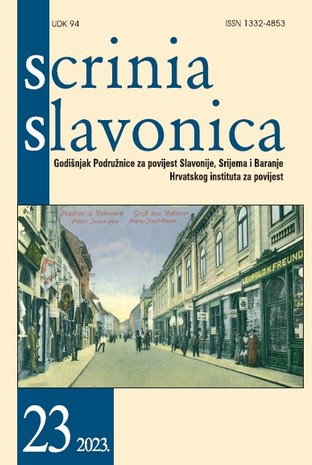Baranja, Slavonija i Srijem u nizozemskim i flamanskim putopisima 16. i 17. stoljeća
Baranya, Slavonia and Syrmia in sixteenth- and seventeenth-century Dutch and Flemish travelogues
Author(s): Maja PerićSubject(s): Cultural history, Regional Geography, Local History / Microhistory, 16th Century, 17th Century
Published by: Hrvatski institut za povijest
Keywords: travelogues; Low Countries; Baranya; Slavonia; Syrmia; sixteenth century; seventeenth century;
Summary/Abstract: On the basis of five representative travel accounts by travellers from the Low Countries (Ogier Gisleen van Busbeke, Karel Rym, Lambert Wyts, Levinus Rym, Carel Quina), an attempt is made to form a picture of the wealth of information that can be extracted from this type of narrative source. In the past, when studying Slavonia, Baranya and Syrmia, it was often decided not to use travel accounts, or only to use them as a supplement in historical research. The argument often put forward is that travel reports are based on possible sensational, strategic and well thought-out descriptions which are not always completely true, but are in line with what was customary for this type of sources. In particular, sources made by travellers from the Low Countries who travelled through Baranya, Slavonia and Syrmia are often ignored in such studies. The most obvious reason is of course lack of knowledge of the Dutch language and the feeling that this Western European region was too far removed from this region in South-Eastern Europe to make a useful contribution to the historiographical framework. Nothing could be farther from the truth. The analysis has clearly shown that there is much to be gleaned from the sources about various aspects of daily life. Although in some cases it is not really clear where the line between truth and nonsense lies, the travel accounts are not only useful to learn something about toponymy or fortresses and Ottoman presence in this region that covers part of present-day Croatia and Serbia. The travellers who chose the diplomatic route via the Danube for diplomatic reasons are clearly distinguished from the one traveller in the selection who chose the same route for curious and religious reasons. Whereas the diplomatic envoys mainly talk about the physical landscape, it is clear that Quina was particularly attentive to the people and nature in his surroundings. The latter’s travel report also distinguished itself from the rest by the way it was written. Where he went into detail, the others remained somewhat superficial. It is clear that the underlying reason for the journey had a clear impact on what was described in the travel accounts. The five travel accounts are only a few of the sources that exist concerning the connection between the Low Countries and this region of Europe. The increasing presence of the Low Countries in the Ottoman Empire also meant that more ambassadors, consuls, envoys and confidants set out on the road to Constantinople and left written sources behind. Here it is important to mention, among others, the many existing letters of Cornelis Haga, Coenraad van Heemskerck and many other Dutch representatives in the Ottoman Empire since the beginning of the seventeenth century. There are some other sources that have not received enough attention until now, but they could also tell us something about what people from such a distant region had to say about Baranya, Slavonia and Syrmia. In a broader analysis, in which literary works and other types of sources can be combined, it would be possible to find out to what extent the Low Countries differ from others in their description. This research has mainly shown that, from the strategic reasons of the diplomatic missions, one wanted to emphasise the conditions in which these Christians lived, while from the other source one could find out what occupied the local inhabitants in their daily lives. It is precisely because of the variation and the differences or the remarkable similarities in travel accounts that this type of source deserves more attention in the future when describing certain aspects in the regions of sixteenth or seventeenth century Slavonia, Baranya and Syrmia.
Journal: Scrinia Slavonica
- Issue Year: 2023
- Issue No: 23
- Page Range: 63-92
- Page Count: 30
- Language: Croatian

